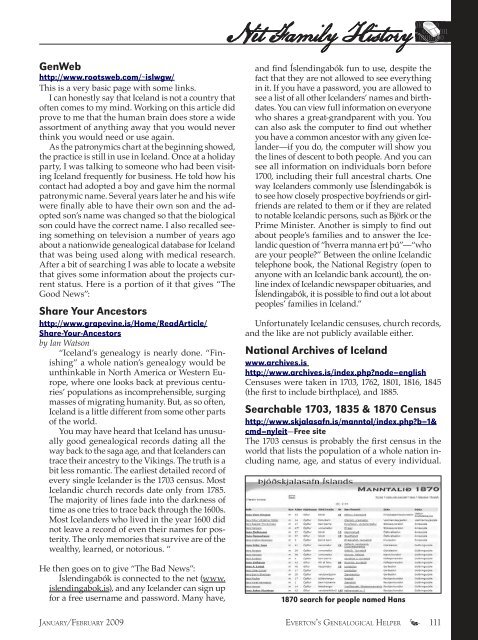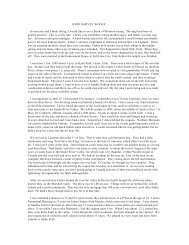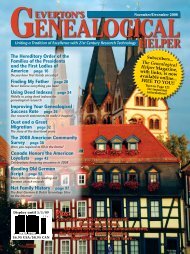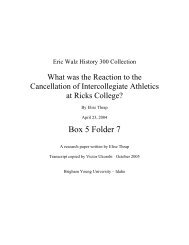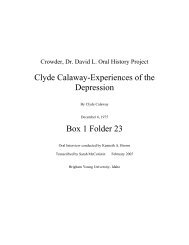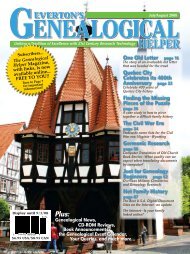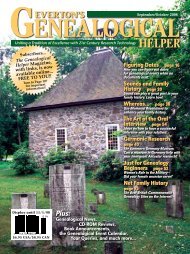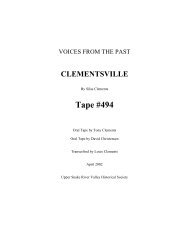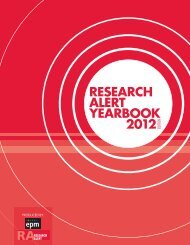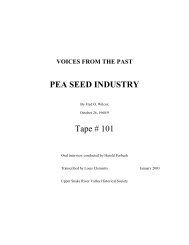HelPeR - BYU Idaho Special Collections and Family History
HelPeR - BYU Idaho Special Collections and Family History
HelPeR - BYU Idaho Special Collections and Family History
Create successful ePaper yourself
Turn your PDF publications into a flip-book with our unique Google optimized e-Paper software.
Net <strong>Family</strong> <strong>History</strong> 010 01 0<br />
101<br />
01010100<br />
GenWeb<br />
http://www.rootsweb.com/~islwgw/<br />
This is a very basic page with some links.<br />
I can honestly say that Icel<strong>and</strong> is not a country that<br />
often comes to my mind. Working on this article did<br />
prove to me that the human brain does store a wide<br />
assortment of anything away that you would never<br />
think you would need or use again.<br />
As the patronymics chart at the beginning showed,<br />
the practice is still in use in Icel<strong>and</strong>. Once at a holiday<br />
party, I was talking to someone who had been visiting<br />
Icel<strong>and</strong> frequently for business. He told how his<br />
contact had adopted a boy <strong>and</strong> gave him the normal<br />
patronymic name. Several years later he <strong>and</strong> his wife<br />
were finally able to have their own son <strong>and</strong> the adopted<br />
son’s name was changed so that the biological<br />
son could have the correct name. I also recalled seeing<br />
something on television a number of years ago<br />
about a nationwide genealogical database for Icel<strong>and</strong><br />
that was being used along with medical research.<br />
After a bit of searching I was able to locate a website<br />
that gives some information about the projects current<br />
status. Here is a portion of it that gives “The<br />
Good News”:<br />
Share Your Ancestors<br />
http://www.grapevine.is/Home/ReadArticle/<br />
Share-Your-Ancestors<br />
by Ian Watson<br />
“Icel<strong>and</strong>’s genealogy is nearly done. “Finishing”<br />
a whole nation’s genealogy would be<br />
unthinkable in North America or Western Europe,<br />
where one looks back at previous centuries’<br />
populations as incomprehensible, surging<br />
masses of migrating humanity. But, as so often,<br />
Icel<strong>and</strong> is a little different from some other parts<br />
of the world.<br />
You may have heard that Icel<strong>and</strong> has unusually<br />
good genealogical records dating all the<br />
way back to the saga age, <strong>and</strong> that Icel<strong>and</strong>ers can<br />
trace their ancestry to the Vikings. The truth is a<br />
bit less romantic. The earliest detailed record of<br />
every single Icel<strong>and</strong>er is the 1703 census. Most<br />
Icel<strong>and</strong>ic church records date only from 1785.<br />
The majority of lines fade into the darkness of<br />
time as one tries to trace back through the 1600s.<br />
Most Icel<strong>and</strong>ers who lived in the year 1600 did<br />
not leave a record of even their names for posterity.<br />
The only memories that survive are of the<br />
wealthy, learned, or notorious. “<br />
He then goes on to give “The Bad News”:<br />
Íslendingabók is connected to the net (www.<br />
islendingabok.is), <strong>and</strong> any Icel<strong>and</strong>er can sign up<br />
for a free username <strong>and</strong> password. Many have,<br />
<strong>and</strong> find Íslendingabók fun to use, despite the<br />
fact that they are not allowed to see everything<br />
in it. If you have a password, you are allowed to<br />
see a list of all other Icel<strong>and</strong>ers’ names <strong>and</strong> birthdates.<br />
You can view full information on everyone<br />
who shares a great-gr<strong>and</strong>parent with you. You<br />
can also ask the computer to find out whether<br />
you have a common ancestor with any given Icel<strong>and</strong>er—if<br />
you do, the computer will show you<br />
the lines of descent to both people. And you can<br />
see all information on individuals born before<br />
1700, including their full ancestral charts. One<br />
way Icel<strong>and</strong>ers commonly use Íslendingabók is<br />
to see how closely prospective boyfriends or girlfriends<br />
are related to them or if they are related<br />
to notable Icel<strong>and</strong>ic persons, such as Björk or the<br />
Prime Minister. Another is simply to find out<br />
about people’s families <strong>and</strong> to answer the Icel<strong>and</strong>ic<br />
question of “hverra manna ert þú”—“who<br />
are your people” Between the online Icel<strong>and</strong>ic<br />
telephone book, the National Registry (open to<br />
anyone with an Icel<strong>and</strong>ic bank account), the online<br />
index of Icel<strong>and</strong>ic newspaper obituaries, <strong>and</strong><br />
Íslendingabók, it is possible to find out a lot about<br />
peoples’ families in Icel<strong>and</strong>.”<br />
Unfortunately Icel<strong>and</strong>ic censuses, church records,<br />
<strong>and</strong> the like are not publicly available either.<br />
National Archives of Icel<strong>and</strong><br />
www.archives.is<br />
http://www.archives.is/index.phpnode=english<br />
Censuses were taken in 1703, 1762, 1801, 1816, 1845<br />
(the first to include birthplace), <strong>and</strong> 1885.<br />
Searchable 1703, 1835 & 1870 Census<br />
http://www.skjalasafn.is/manntol/index.phpb=1&<br />
cmd=nyleit—Free site<br />
The 1703 census is probably the first census in the<br />
world that lists the population of a whole nation including<br />
name, age, <strong>and</strong> status of every individual.<br />
1870 search for people named Hans<br />
Ja n ua ry/Fe b r u a r y 2009 Ev e r t o n’s Ge n e a l o g i c a l He l p e r © 111


